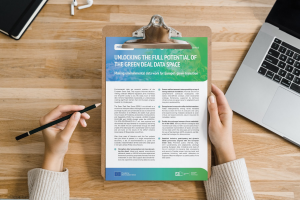
Climate protest at the Brandenburg Gate. Source: Nico Roicke.
May 9 is a day of celebration for the European Union. Together we are proud to celebrate our common achievements towards unity, peace and the defense of European values. On this day in 1950, the then French foreign minister, Robert Schuman, proposed the creation of a European Coal and Steel Community (ECSC) comprising France, West Germany, Italy, the Netherlands, Belgium and Luxembourg. Among its objectives were to ensure peace on the continent and unity among its members. Time and the efforts of many European citizens have built from this seed the institution that now represents the European Union.
Science and technology were from the beginning one of the important issues addressed by the precursors of the EU. Coal and steel provided a necessary cohesion between nations and people who found in working together a way to understand Europe. The EU is now facing new challenges transversally structured by action against climate change and the development of a sustainable economy. The European Green Deal is the ambitious and comprehensive strategy that will lead the EU to become the world’s first resource-efficient and competitive economy, achieving net-zero greenhouse gas emissions by 2050. Data, services and digital technologies play a pivotal role in realizing this green transformation. The European Strategy for Data supports the creation of a single European Data Space, a single market for data with secure and easy data sharing mechanisms that boosts growth and value within the EU laws and regulations. The route towards materializing these aspirations involves the prior creation of up to 14 common European data spaces, among which the Green Deal Data Space (GDDS) among which the Green Deal Data Space (GDDS) appears as one of the most transversal and relevant, due to the scope of its objectives and aspirations.
Climate change, circular economy, pollution, biodiversity and deforestation are hot topics for the development of the GDDS. These priorities respond to established European directives such as the 2030 Biodiversity Strategy or the European Climate Law, as an integral part of the Commission’s strategy to implement the Paris Agreement and the United Nations Sustainable Development Goals. On this Europe Day we want to highlight how our pilot cases in biodiversity, water pollution and air quality are aligned with being part of informing decision making and facilitating the implementation of these policies through scientific data and knowledge.
Protecting biodiversity
Habitat connectivity describes how the landscape facilitates or impedes movement of species among areas with the resources they need. Improved and conserve habitat connectivity indices is essential to support the nature protection objectives of the EU Biodiversity Strategy for 2030, which recognizes the need to “create and integrate ecological corridors as part of a Trans-European Nature Network to prevent genetic isolation, allow for species migration and to maintain and enhance healthy ecosystems”.
Similarly, the Convention on Biodiversity states for a “net gain in connectivity and integrity of natural systems and that at least 20% of degraded terrestrial ecosystems are under restoration, ensuring connectivity and focusing on priority ecosystems”.
National, regional, and local governments require standardized metrics to make strategic decisions for protected areas, zoning, agricultural practices, land remediation, and international reporting.
In this pilot case we are looking particularly at terrestrial species, i.e. all those that do not need the aquatic environment to carry out any vital process. We are particularly concerned about the situation of endangered species. The last “State of Nature in Catalonia 2020″ report stated that “wildlife populations in Catalonia have declined by an average of 25% in the last 18 years.
Water pollution
Urban lakes are crucial sources of freshwater for humans and can have lots of ecological benefits. They function as biodiversity hotspots for many water and terrestrial species, they are valuable climatic refuges and provide leisure that benefit citizens both physical and mental health.
Water pollution is also a matter of public health, environmental awareness, and socio-economic concern. The EU Action Plan “Towards a Zero Pollution for Air, Water and Soil” defines the European vision for achieving zero pollution by 2050 in the framework of the European Green Deal. One of the established objectives include “improving water quality by reducing waste by 30%”, for which proper monitoring is essential. This pathway also recognises that depolluted and re-naturalised sites could be potential public green areas that enhance better mental and physical well-being.
Furthermore, the ongoing revision of the Urban Wastewater Treatment Directive will bring new milestones aligned with the zero-pollution goals including stricter urban wastewater management plans for regulating collecting systems and against pollution from rain and storm water. In this regard, new monitoring obligations would also be introduced.
Our water pilot aims to improve the health of Berlin’s small lakes by facilitating access to knowledge about their status. To this end, we are developing indices based on water quality, mainly shaped by urban catchment areas, and water availability, largely dependent on soil sealing and drainage systems.
Air Quality
Poor urban air quality causes serious health issues across Europe. Accurate and localized monitoring is the first step to address this. Currently, air quality monitoring networks are sparse and, even if of good quality, still face challanges in providing a high resolution overview of air pollution. The air we breathe is eventually contaminated by particulate matter (PM), ozone (O₃), nitrogen dioxide (NO₂), sulfur dioxide (SO₂) and carbon monoxide (CO), which present robust evidence of risks for public health, according to the WHO. These pollutants originate from natural sources and human activity, the main contributor being the inefficient combustion of fossil fuels and biomass.
Advocating for a proper air quality is crucial to achieve the Green Deal goals of zero pollution in air, water and soil which targets “ improving air quality to reduce the number of premature deaths caused by air pollution by 55%” and “aligning the air quality standards more closely to the latest recommendations of the World Health Organisation”.
Addressing this issue is also key for achieving the SDG target 3.9, which aims to “substantially reduce the number of deaths and illnesses from hazardous chemicals and air, water and soil pollution and contamination” by 2030 and the SDG target 11.6 which ambitions to “reduce the adverse per capita environmental impact of cities, including by paying special attention to air quality and municipal and other waste management”. Tackling air pollution also benefits SDG target 13 on climate action as compliance with climate change mitigation policies could reduce PM2.5 emissions by 17% and prevent more than 74,000 premature deaths annually in Europe.
Our primary goal is to use high-resolution data sets to enable better health-related decisions and improve the approaches for assessing and monitoring the quality of air in urban areas, with an emphasis on local environments.





